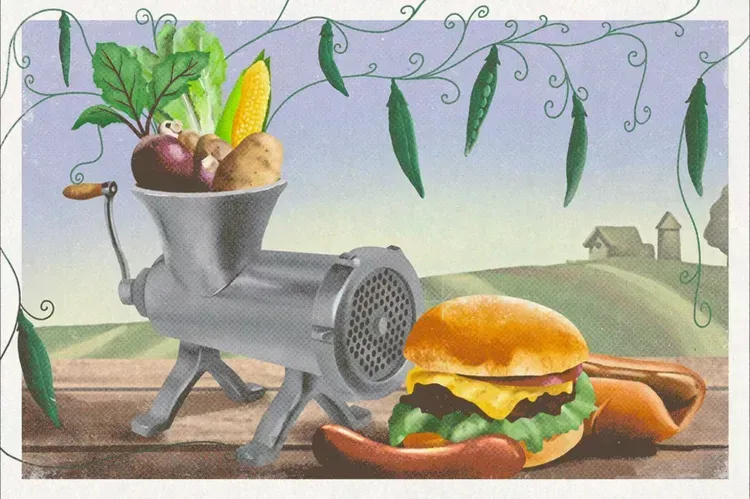Prevention and Treatment of Tick Bites
Jaynie Norman • May 23, 2023
The body content of your post goes here. To edit this text, click on it and delete this default text and start typing your own or paste your own from a different source.
You might also like
Jaynie Norman

By Chuck Abbott Successful Farming With U.S. approval of cultivated chicken grown in fermentation vats, farm-state lawmakers filed companion bills in the House and Senate on Tuesday to require alternative proteins, such as plant-based foods, to carry the words “imitation” or “lab-grown” on their labels. Sponsors said they wanted to prevent confusion in the supermarket between “real farm-raised meat” and its rivals. Plant-based meats accounted for 2.5% of retail packaged meat sales in 2022, according to the Good Food Institute, a think tank and network of organizations “working to accelerate alternative protein innovation.” Only a trickle of cultivated chicken is on the U.S. market at present. Upside Foods said last September it would build a commercial-scale plant to produce cell-cultured meat products in suburban Chicago. The USDA is working on label regulations for cultivated meat. In the interim, it decided Upside Foods and Good Meat, which were cleared last summer by USDA to sell cultivated meat to consumers, would label their products as cell-cultivated chicken. “The American consumer deserves to know what they are eating and feeding their family,” said sponsor Rep. Mark Alford, Missouri Republican. “It’s only fair that all products are labeled fairly.” Kansas Sen. Roger Marshall said, “Distinguishing between a black-bean burger and an actual beef burger shouldn’t be hard.” Under the legislation, foods made with plant protein and that are sold with a name associated with products from a food-bearing animal or that are created to taste or look like them would be required to carry the word “imitation” on the label or a word to show the source of the protein. “Meatless chicken tenders” would be one possibility, according to a summary of the bill. Similarly, labels for cultivated meat would include “cell-cultured” or “lab-grown” immediately adjacent to the name of the food. The bill was backed by the largest groups speaking for cattle, hog, sheep, and chicken producers, the American Farm Bureau Federation, and the National Association of State Departments of Agriculture. Livestock producers have argued for years for restrictive labels to prevent alternative proteins from using names associated with animals. A one-page summary of the bill is available here . To read the text of the legislation, click here .

The U.S. Food and Drug Administration (FDA) announced in June 2021 that all medically important antimicrobials for food-producing animals and pets will move from over-the-counter (OTC) to prescription (Rx) effective June 2023 . A prescription is already required for most antibiotics delivered to livestock, and the remaining three categories of injectable antibiotics available over-the-counter will soon be joining the list of medically important antimicrobials that require a veterinarian’s prescription. To add to the stress of raising livestock, now things will change again which is going to influence the ag industry overall. I hope that this list of medications will give people a chance to read it and become familiar with the situation before the change comes in June of 2023. Changes Coming are as follow: In 2018, the FDA established a 5 year plan for supporting antimicrobial supervision by veterinarians. The plans purpose to address antimicrobial resistance using only medically necessary drugs as necessary to prevent, treat and control disease. It has to be determined by a licensed veterinarian if it is necessary, but you won’t have to order the prescriptions from the vet directly. You will, however, need to establish a Veterinary-Client-Patient Relationship (VCPR) if certain animals are not examined regularly. Popular Products Will Require Prescriptions Following a recent penicillin shortage, soon producers will get hit with this change that once again impacts access to antibiotic therapy for animals. When you’ve used them for so long as OTC meds to treat pneumonia or shipping fever in your livestock, Now, the change will be to establish the relationship with your veterinarian to get the prescriptions for these meds. Here is the list by active ingredients. The following are some products that will be seeing label changes to prescription-only status: Oxytetracyclines Injectables: Liquamycin LA-200, Noromycin 300 LA, Bio-Mycin 200, Agrimycin 200, etc. Boluses: Terramycin Scours Tablets, OXY 500 Calf Boluses Penicillins (Penicillin G procaine, penicillin G benzathine) Injectables: Penicillin Injectable, Dura-Pen, Pro-Pen-G, Combi-Pen 48, etc. Intramammary tubes: Masti-Clear, Go-dry, Albadry Plus Sulfa-based antibiotics (Sulfadimethoxine, sulfamethazine) Injectables: Di-Methox 40%, SulfMed 40% Boluses: Albon, Sustain III Cattle & Calf Boluses, Supra Sulfa III Cattle & Calf Boluses Tylosin Injectables: Tylan 50, Tylan 200 Cephapirin, cephapirin benzathine Intramammary tubes: ToDAY and ToMORROW Additionally, several swine medications fall under the new guidance: Lincomycin Injectables: Lincomix 100, Lincomix 300, LincoMed 100, LincoMed 300 Gentamicin Injectables: Garasol, Gentamicin Piglet Injection ToDay Mastitis Treatment for Lactating C ows
